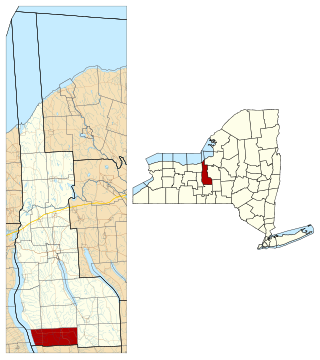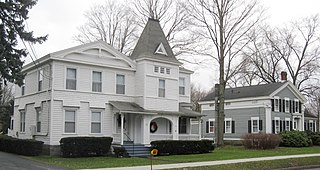
Genoa is a town in Cayuga County, New York, United States. The population was 1,816 at the 2020 census. The town is named after Genoa in Italy.

Locke is a town in Cayuga County, New York, United States. The population was 1,877 at the 2020 census. The town was named after John Locke, an English philosopher, and is the birthplace of Millard Fillmore, 13th President of the United States.

Summerhill is a town in Cayuga County, New York, United States. The population was 1,217 at the 2010 census. The town name is that of a location in Ireland. Summerhill is in the southeastern corner of the county and is northeast of Ithaca.
Cortland West is a census-designated place and region in Cortland County, New York, United States. The population was 1,356 at the 2010 census.

Harford is a town in Cortland County, New York, United States. The population was 943 at the 2010 census. Harford is in the southwestern corner of Cortland County and is south of Cortland.
Denmark is a town in Lewis County, New York, United States, named after the Kingdom of Denmark in northern Europe. The population was 2,860 at the 2010 census. The town is on the northwestern border of Lewis County and lies east of Watertown.

Cayuta is a town in Schuyler County, New York, United States. As of the 2020 census, the population was 508.
Covert is a town in Seneca County, New York, United States. The population was 2,135 at the 2020 census.
Enfield is a town in Tompkins County, New York, United States. The population was 3,401 at the 2020 census.

Forest Home is a census-designated place (CDP) in Tompkins County, New York, United States. The population was 572 at the 2010 census.
Newfield is a census-designated place (CDP) in Tompkins County, New York, United States. The population was 759 at the 2010 census.
Northeast Ithaca is a census-designated place (CDP) in Ithaca (town), New York in Tompkins County, New York, United States. The population was 2,655 at the 2000 census.

Trumansburg is a village in Tompkins County, New York, United States. The population was 1,797 at the 2010 census. The name incorporates a misspelling of the surname of the founder, Abner Treman. The Tremans spelled their surname several different ways; "Truman," however, was not one of them. The village's application for a post office established the present spelling. The Village of Trumansburg is located within the Town of Ulysses and is northwest of Ithaca, New York.
The village of Moravia in Cayuga County, New York, United States is a community with population of about 1,200. The village of Moravia is in the southern part of the town of Moravia and is south of Auburn.
Van Etten is a town in Chemung County, New York, United States. It is part of the Elmira Metropolitan Statistical Area. The population of the town was 1,541 at the 2020 census. The town is named for the two brothers who founded the village of Van Etten in it. The town is at the northeastern corner of the county, northeast of Elmira.

Dryden is a village in Tompkins County, New York, United States. The population was 1,890 at the 2010 census. The name was assigned by a clerk, interested in the classics, to honor poet John Dryden. The village is in the town of Dryden, east of Ithaca. It is near the border of Cortland County.

Groton is a census-designated place (CDP) comprising the main village in the town of Groton in Middlesex County, Massachusetts, United States. The population of the CDP was 1,353 at the 2020 census, out of 11,315 in the entire town of Groton.

Dryden is a town in Tompkins County, New York, United States. The population was 14,435 at the 2010 census. The town administers an area that includes two villages, one also named Dryden and one named Freeville, as well as a number of hamlets. The town is on the county's eastern border, east of Ithaca, in the Finger Lakes region.
Groton is a town in Tompkins County, New York, United States. The population was 5,950 at the 2010 census. The name is taken from Groton, Massachusetts.
Lansing is a village in Tompkins County, New York, United States, and a suburb of Ithaca. The population was 3,648 at the 2020 census.











